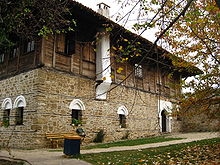Arbanasi (Veliko Tarnovo)
It is known for the rich history and large number of historical monuments, such as 17th- and 18th-century churches and examples of Bulgarian National Revival architecture, which have turned it into a popular tourist destination.The earliest written document that marks the beginning of Arbanasi's history is a royal decree by the Ottoman sultan Suleiman the Magnificent from 1538, according to which the sultan offered the lands of the modern localities of Arbanasi, Lyaskovets, Gorna Oryahovitsa and Dolna Oryahovitsa to his son-in-law Grand Vizier Rustem Pasha as a gift.The settlement had over 1,000 houses at the time, its population consisting mostly of eminent merchant families who traded in Transylvania (mostly Sibiu and Braşov), the Danubian Principalities, Russia and Poland.In the 18th century, Arbanasi was regularly donated by the Phanariote rulers of Wallachia, and a number of expelled Wallachian nobles settled temporarily in the village, e.g. Nicolae Brâncoveanu, Ioan (Ianache) Văcărescu, etc.This, however, did not reflect the local population's national self-consciousness, as Arbanasi residents took part in the organized armed struggle of Bulgarians that ultimately led to the Liberation of Bulgaria from Ottoman rule as a consequence of the Russo-Turkish War of 1877-78.


BulgariaTime zoneArea codeBulgarianAlbanianVeliko Tarnovo MunicipalityVeliko Tarnovo ProvinceGorna OryahovitsaBulgarian National RevivalTurkishboyarsSecond Bulgarian EmpireIvan Asen II of BulgariaByzantinesKlokotnitsaGeorgi RakovskiOttomansultanSuleiman the MagnificentLyaskovetsDolna Oryahovitsason-in-lawGrand VizierGreeksEpirusOrthodoxSlavicChristianTransylvanianSigismund BáthoryRoman CatholicPetar Bogdan BakshevHungaryPolandMuscovyPatriarchate of ConstantinopleBraşovDanubian PrincipalitiesRussiacoppergoldsmithingvine-growingPhanarioterulers of WallachiaCantacuzinoFilipescuplaguecholeraWallachiaTetevenBalkan MountainsCrimean WarRusso-Turkish War of 1877-78Arbanasi NunatakLivingston IslandSouth Shetland IslandsAntarcticaIlarion DragostinovVasile LupuiconostasisWayback MachineVeliko TarnovoDebeletsKilifarevoArbanasiBalvanBukovetsDichinLedenikNikyupPrisovoSamovodeneShemshevoVodoleyRebellion of Asen and PetarSiege of TarnovoSecond Tarnovo UprisingTarnovo ConstitutionYantra RiverTrapezitsa HillPass of the RepublicChurch of SS. Peter and PaulChurch of St DemetriusSS. Forty Martyrs ChurchPatriarchal CathedralTsarevetsVeliko Tarnovo UniversityNicopolis ad IstrumSaint EvtimiyGregory TsamblakPetko SlaveykovStefan StambolovVasil ZlatarskiKrassimir BalakovMaria IlievaKotoōshūGrigor NachovichDimitar GrekovEmiliyan StanevMitkalotoTheodosius of TarnovoFilip Totyu